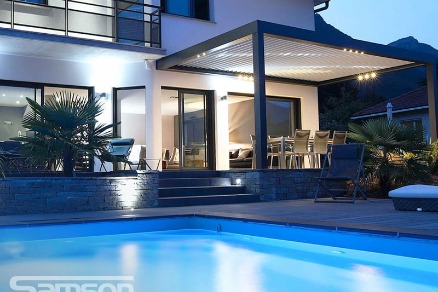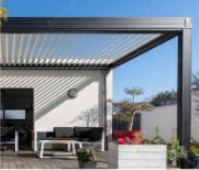Inspiration
We Have A Number Of Sources Of Solutions Thant Should Prove Inspirational For You.

A common disadvantage reported, which is possibly obvious, but not to everyone, is that a bladed aluminium louvre roof protects from the rainfall only when the blades are totally closed up. With the blades closed you completely block out all natural light and it can be very dark underneath such a system even in the daytime. Look at a glass veranda roof, which not only protects with 100% waterproof guarantee, you also get all the natural light all the time.
Many cheaper louvre roof bladed roof pergolas will only rotate less or to 90 degrees, where more expensive and generally electric operated systems can rotate up to 140 degrees to give fresh air flow in 2 directions and also more sunlight control.
Most louvre pergolas have static blades so you can only ever get partial light ingress, but there are retractable systems where the roof rotates the blades to a vertical position and then the blades can slide along to provide up to 80% complete open air space. You may always feel a little oppressed under a bladed roof if there isn’t full sunlight. The louvre blade roof system originated in far sunnier climates compared to the UK, where we actually want to get more sunlight generally when it appears and not less…
A proper specified and usually electric operated, louvre pergola, with the ability to add sliding glass doors or other systems to the side can create a great outdoor space, but we would always recommend you have good LED lighting built in and they are actually often better for evening use generally, although never insulated in any way…

The straight answer is no, Many brands claim to be, but very few outdoor pergola systems are 100% waterproof.
The biggest area for failure with a louvre blade pergola system is the rainwater guttering system used. The rainwater is meant to run off the slightly sloped angle of the aluminium blades when closed and into an internal rainwater guttering system around the perimeter of the roof structure on all 4 sides. The guttering is internal and if the rainfall is ever so heavy that it overwhelms the gutters, then the rainwater will spill over and out inside the pergola.
Different pergolas have different size guttering and this is usually a price level scaling, with commercial systems having the largest guttering.
Many cheap louvre pergolas, many of which have flooded the UK market since Covid hit the UK, are quite flimsy in their profiles and would struggle in both high winds or heavy rainfall to provide weather protection and also remain stable.
Quite simply the more you pay for a louvre pergola the more material content you will get and the heavier duty the system will be, along with larger rainwater guttering too.
A good judge of the quality can also be if the pergola is built with the ability to take additional sliding glass doors or other side infills either at the time of purchase or further down the line..
All louvre pergolas are built as outdoor living rooms and as such you should not expect to ever be 100% rain protected in reality..
Any brands claiming 100% waterproof are certainly very brave…
A ‘bioclimatic pergola’ is a term used to describe an electric operated aluminium pergola system using tilting aluminium roof slats or blades. This type of pergola creates and assists with air flow using the direction and angle of the roof blades and helps control the climate underneath the pergola structure.
(more…)